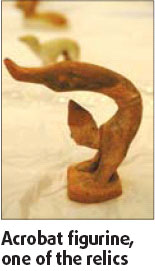It was no more than 5 cm tall, a pink pottery figurine of an acrobat with back arched.
But when the Ming Dynasty (1368-1644) relic was taken out of its wooden box, the 20-odd people in the room lucky enough to see it emerge were awed into silence.

The figurine is one of the 156 Chinese cultural relics that were smuggled out of the country more than a decade ago. They were returned to the country on Thursday and revealed to the group of historians, officials and members of the press at the China Cultural Heritage Circulation Center on Friday.
The latest batch of relics being returned is the largest in the past five years, Song Xinchao, director of the museum department of the State Administration of Cultural Heritage (SACH), said.
Song had gone to Copenhagen to claim the relics on behalf of the Chinese government earlier this week.
The relics date back to between 2,000 BC and the Ming Dynasty. Historians said that they might have been raided from tombs in Shaanxi, Shanxi and Sichuan provinces in the 1990s.
Song said archaeologists could not identify the tombs' locations.
But "we can judge from the relics that at least one or two of the tombs belong to kings", Song said.
The oldest piece - a delicate jade ring from about 2,000 BC - could have been illegally excavated from a king's tomb because it was a symbol of royalty, he said.
The smuggled relics came to light in February 2006, when Danish police received a report about "suspicious antiques" in a household in Copenhagen and discovered the 156 pieces.
The Chinese embassy in Copenhagen was informed immediately, and Chinese historians certified that they were from China.
With the help of Danish lawyers, SACH officials and experts began the process of claiming the relics through Danish courts.
Their strongest evidence was four characters inscribed on a pottery ox and elephant.
The characters read: "Ji Ji Lao Ren", or "Old Man Ji Ji".
"It occurred to us that we could try to find if there were the same four characters on relics in Chinese museum collections," Sun Ji, a historian at the National Museum of China who was involved in the claim, said.
"After much effort, we found them on several pottery sculptures in the Xi'an Museum. They were what the owner of an excavated tomb - a well-known artist in the Yuan Dynasty (1271-1368) - called himself."
With the evidence in hand, the Chinese government was given the right to the relics at a Danish court ruling on Tuesday.
(China Daily April 12, 2008)